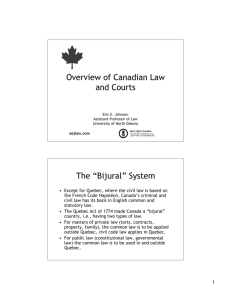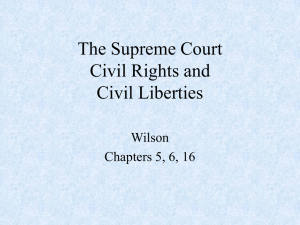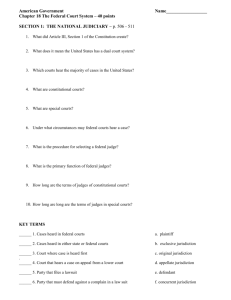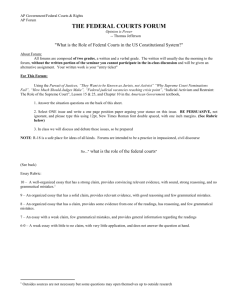the structure and role of a supreme court in a federal system
advertisement
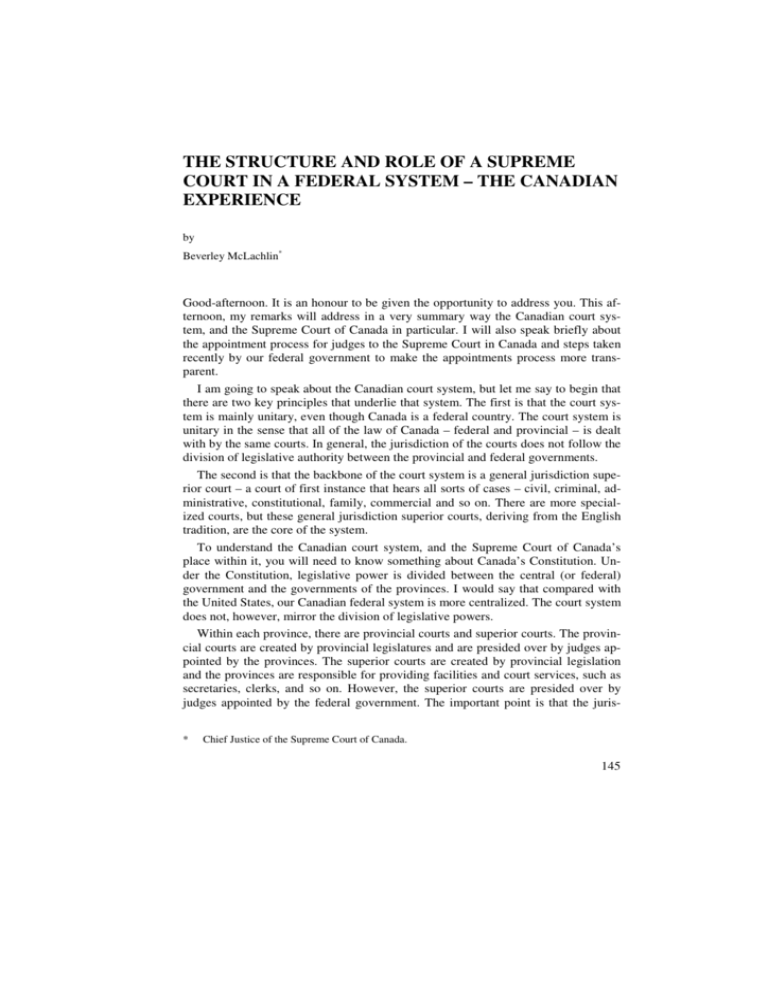
THE STRUCTURE AND ROLE OF A SUPREME COURT IN A FEDERAL SYSTEM – THE CANADIAN EXPERIENCE by Beverley McLachlin* Good-afternoon. It is an honour to be given the opportunity to address you. This afternoon, my remarks will address in a very summary way the Canadian court system, and the Supreme Court of Canada in particular. I will also speak briefly about the appointment process for judges to the Supreme Court in Canada and steps taken recently by our federal government to make the appointments process more transparent. I am going to speak about the Canadian court system, but let me say to begin that there are two key principles that underlie that system. The first is that the court system is mainly unitary, even though Canada is a federal country. The court system is unitary in the sense that all of the law of Canada – federal and provincial – is dealt with by the same courts. In general, the jurisdiction of the courts does not follow the division of legislative authority between the provincial and federal governments. The second is that the backbone of the court system is a general jurisdiction superior court – a court of first instance that hears all sorts of cases – civil, criminal, administrative, constitutional, family, commercial and so on. There are more specialized courts, but these general jurisdiction superior courts, deriving from the English tradition, are the core of the system. To understand the Canadian court system, and the Supreme Court of Canada’s place within it, you will need to know something about Canada’s Constitution. Under the Constitution, legislative power is divided between the central (or federal) government and the governments of the provinces. I would say that compared with the United States, our Canadian federal system is more centralized. The court system does not, however, mirror the division of legislative powers. Within each province, there are provincial courts and superior courts. The provincial courts are created by provincial legislatures and are presided over by judges appointed by the provinces. The superior courts are created by provincial legislation and the provinces are responsible for providing facilities and court services, such as secretaries, clerks, and so on. However, the superior courts are presided over by judges appointed by the federal government. The important point is that the juris* Chief Justice of the Supreme Court of Canada. 145 McLachlin diction of the provincial and superior court is not divided in accordance with the legislative powers under the Constitution between federal and provincial government. The provincial courts are given jurisdiction by both provincial and federal laws; the same is true of superior courts. As an example, in Canada, under the Constitution criminal law is a matter within the legislative competence of the federal government. However, the federal Criminal Code gives jurisdiction over many crimes to the provincial courts with the result that a provincial court presided over by a provincial judge may be the site of a trial of a person charged under the federal Criminal Code. To take another example, property and contract matters are, in the main, matters for the provincial legislatures. But a lawsuit founded on a contract or concerning property will take place in the superior courts of the provinces, presided over by a judge appointed by the federal government. There are, however, some purely federal courts in the sense that these courts are created by federal legislation and presided over by judges appointed by the federal government. In this group are the Federal Court and the Federal Court of Appeal which deal with judicial review of federal administrative tribunals, certain types of claims against the federal government, and some other matters. Another is the Tax Court of Canada which deals with disputes between citizens and the federal tax authorities. There is another federal court, but it is quite different from the two I have just described. I am referring to the Court over which I preside, the Supreme Court of Canada. It is a federal court in the sense that the judges are appointed by the federal government and that the facilities and staff of the Court are a federal responsibility. However, the Court is a general court of appeal for all of Canada; it hears appeals in both federal and provincial law cases originating in the provincial, superior and federal courts. The Supreme Court of Canada is thus a national court. In Canada, there is no separate constitutional court. The ordinary courts may and indeed must deal with any constitutional issue which arises in a case properly before that court for determination. Exercising its role as the final court of appeal for Canada, the Supreme Court of Canada is also the court in Canada that provides final and authoritative decisions on constitutional matters, as well as on almost all other legal questions. In the same way, there is in Canada no separate administrative law court. Judicial review of administrative action is carried out by the superior courts in the provinces and territories and by the Federal Court, and ultimately, on appeal to the Supreme Court of Canada. The Constitution was of utmost importance in that it founded a united Canada. The Constitution is further important in that it gave birth to the Supreme Court of Canada, by defining the basic elements of the judicial system in Canada: section 101 of the Constitution provided for the establishment of a general court of appeal for the country. In essence, it was this legislative lifeline which conferred upon the 146 Structure and Role of a Supreme Court in a Federal System - The Canadian Experience federal government the legal authority to create the Supreme Court. The Supreme Court of Canada was established by an ordinary act of Parliament in 1875, eight years after Confederation. I believe it is fair to say that throughout its first century in history, the Supreme Court did not usually command public attention; its judges were generally not wellknown and the media coverage was meagre and often inaccurate. Because it did not draw its powers from within the four corners of the Constitution, it was not a visible constitutional institution possessed of independent and inherent authority, in contrast, for example, to the Supreme Court of the United States. Further, while the Constitution invited Parliament to create the Court, it did not provide for the abolition of the appellate procedure in operation at the time of Confederation. That procedure permitted judicial decisions from Canada to be appealed to the Judicial Committee of the Privy Council in London, England. In 1949, all appeals to the Privy Council were abolished. The Supreme Court truly grew up at that point, both judicially and legally speaking. Canada is a constitutional democracy. All powers, whether of Parliament, the Executive or the courts, must be exercised in accordance with the Constitution. In Canada our Constitution explicitly confers certain powers on unelected bodies, notably the courts. First, the courts define the precise contours of the division of legislative powers between the federal and provincial governments within the constraints imposed by the Constitution Act, 1867. Second, the courts rule on legislation alleged to be unconstitutional for violation of the Charter, and in doing so define the scope of constitutional rights and freedoms. Third, the courts exercise de facto supervision over the hosts of administrative tribunals created by Parliament and the Legislatures. Our Constitution requires judges to be the arbiters of constitutional validity. In performing that duty, judges must inevitably strike down legislation, and go against the will of elected representatives, whenever it fails to meet our constitutional standards. By enacting Canada’s constitutional instruments, Parliament and the Provinces decided that this be so. There are three main ways by which cases come before our Court. First, we hear reference cases. These are cases, relatively rare, where the federal government submits a question concerning the constitutionality of a law to the Court for a response. The provincial governments can do the same with respect to the provincial courts of appeal, and when the court of appeal has given an answer, there is a right to have that answer reviewed by the Supreme Court of Canada. The second group of cases are those that come before us by leave of the Court. This is the largest category of cases. The parties must apply to the Court asking it to consider the case on its merits. The Court will agree to do so if the case is one of public importance. Application for leave is made in about 600 cases each year. Leave is granted in about 80. These cases cover the whole range of legal issues: criminal, Charter, constitutional, contract, intellectual property, administrative law, etc. 147 McLachlin The final sort of case that comes to us are appeals as of right in certain criminal cases, the most common being where an acquittal has been set aside by a court of appeal or where there has been a dissent in the court of appeal on a point of law. In these cases, the parties have an automatic right of appeal. The Supreme Court consists of nine judges. Applications for leave to appeal are determined on the basis of written materials (except in rare cases) but all appeals are presented by oral argument with strict time limits. For appeals, the quorum is five, but the Court much more frequently sits with seven or nine judges. The selection of judges to sit on a case is one of the jobs of the Chief Justice. The Court has its own administrative staff who concern themselves with finance, personnel, physical structure, security etc. The Court also employs a group of lawyers who prepare objective summaries of the cases and who assist in the editing, translation and publication of judgments. All judgments of the Court are published in the two official languages of Canada, English and French. Each judge has three law clerks, who have obtained law degrees and who may or may not have been called to the bar. The law clerks assist the judges in researching and drafting legal memoranda on the issues in the appeals. The Supreme Court Act, a federal statute, specifies that there shall be one Chief Justice and eight puisne (from the French “puis né”) judges. Judges are appointed to the Court by the Governor in Council, which is effectively the Prime Minister in consultation with his Cabinet. Although the existence of the Supreme Court of Canada is not expressly enshrined in the Constitution of Canada, the composition of the Court is now constitutionally protected under the terms of the Constitution. The Supreme Court Act specifies that, of the nine judges on the Court, three must be appointed from the Province of Quebec. Quebec is the only province to have a civil law tradition and a Civil Code. As the Supreme Court hears a number of cases raising questions under the Civil Code, it is necessary to have a certain number of judges who are trained in the civil law tradition. Of the remaining six judges, by convention, three judges are appointed from Ontario, one from the Atlantic provinces, one from British Columbia and one from the Prairie provinces. The only statutory requirement for appointment to the Supreme Court of Canada is that the person be or have been a judge of a superior court of a province or a lawyer who has been called to the bar for at least 10 years. Judges on the Supreme Court are entitled to hold office until the age of seventy-five. With the enactment of the Canadian Charter of Rights and Freedoms in 1982, the Court’s role in reviewing government actions and legislation expanded. It is often called upon to rule on legal constitutional questions that may involve a public policy aspect. The process of appointing judges has therefore caught the public attention as an issue of great importance. I think it is fair to say that the process for the appointment of all federal judges has come in for its share of scrutiny and criticism this past 148 Structure and Role of a Supreme Court in a Federal System - The Canadian Experience year. The result is that the House of Commons Standing Committee on Human Rights and Justice is holding hearings this autumn into the process for the appointment of federally-appointed judges. It is, of course, legitimate for the public to seek the best possible way of identifying individuals qualified to perform the judicial task with skill and impartiality. It is equally legitimate to insist that whatever reform is considered, judges should continue to be appointed on the basis of merit and the process of appointing judges should continue to respect judicial independence. Canada’s Constitution vests authority for appointment of federal judges in the executive. For federally-appointed judges other than judges of the highest court, a recommendation is made to the Cabinet by the Minister of Justice for the appointment of puisne judges and by the Prime Minister for the appointment of Chief Justices. The recommendation to Cabinet is made from amongst names which have been previously reported by an independent judicial advisory committee. Before recommending an appointment to Cabinet, the Minister may consult with members of the judiciary and the bar, with his or her appropriate provincial or territorial counterparts, as well as with members of the public. The Supreme Court of Canada has not escaped scrutiny. As a columnist in the Montreal Gazette wrote earlier this year, “Appointing someone to the top court is a very big deal...”1 My esteemed colleague Justice Jack Major announced in August that he will resign in DecemberThe Minister of Justice has instituted a modified process for the appointment of judges to the Supreme Court to provide more transparency. Up until recently, appointments to the Supreme Court were made by upon recommendation by the Prime Minister to Cabinet. Potential candidates were identified through consultations with the Chief Justice of the Supreme Court, chief justices of the relevant region of the country, the provincial attorneys general of the relevant region, and the Canadian Bar Association and the law society of the relevant region. Under the new process, the Minister of Justice will draw up a list of five to eight candidates after having consulted with the Chief Justice of Canada, the attorneys general of the provinces in the region and the local bar association. The Minister will then provide this list to an advisory committee composed of members of Parliament, professionals and other persons of significant stature and responsibility. The advisory committee will assess the candidates and provide an unranked short list of three candidates to the Minister with an assessment of their merit and a full record of the consultations conducted. The Minister will then complete such further consultations as considered necessary and provide his advice to the Prime Minister. The Prime Minister will make his recommendation to Cabinet and, in all but the most exceptional circumstances, the appointment will be made from the short list. After the Prime Minister has announced the choice, the Minister will appear before the 1 Peter Hadekel, “Supreme Court Picks Need to be Openly Vetted” Montreal Gazette (11 August 2005) A12. 149 McLachlin Justice Committee to explain the appointment process and the professional and personal qualities of the appointee. This is the process that is being followed for Justice Major’s replacement. The advisory committee met for the first time on October 17 and has been asked to provide its short list of three unranked candidates to the Minister by November 18. The Minister has stated that the new process is aimed at appointing the best people on merit, considering both the Court’s expertise needs and the desirability of reflecting Canada’s diversity on the bench while recognizing the executive’s continued responsibility for the appointments. The nine-member advisory committee’s members are drawn from a range of constituencies and perspectives and include one from each recognized political party in the Canadian Parliament; a retired judge, a member nominated by the provincial attorneys general of the region; a member nominated by the law societies of the region; and two lay people of recognized stature. The new process for appointments to the Supreme Court of Canada appears to respect the dual requirements of choice based on merit and preservation of judicial independence. In my own view, the goal should be to appoint individuals who embody the most valuable judicial qualities of competence, impartiality, empathy and wisdom. Unlike the appointments process for judges to the Supreme Court of the United States, candidates are not questions on their beliefs, their views on the law or their previous decisions. The prevalent view is that the process adopted in Canada protects judicial independence. It is my hope that this revised selection process will continue to result in the highest quality appointments to our Court. However, I have no doubt that Supreme Court appointments will remain a topic of national and international interest. By way of conclusion, it is a fair comment on my part to say that the Supreme Court has blossomed from a rather obscure court in the late 1880s to a dynamic and functional institution of Canadian life in the 21st century – and one with which I am proud to be associated. The advent of the Canadian Charter of Rights and Freedoms has certainly played a significant role in this blossoming. In 2004, 21 per cent of our cases involved the Charter. As a result, the Court is responsible for defining the values – religious, economic, social and even moral – by which all Canadians should live. As a former Minister of Justice said, “The Charter has awakened the sleeping giant of public opinion. The public has a right to know and a right to be heard.”2 You can appreciate both the difficulty and the burden of such a task. 2 150 The Hon. Kim Campbell, Remarks delivered to the Canadian Bar Association, 1991. Structure and Role of a Supreme Court in a Federal System - The Canadian Experience Thank-you for extending me the opportunity to speak here today. I hope I have been able to shed some light on the way a Supreme Court operates in a federal system. 151


